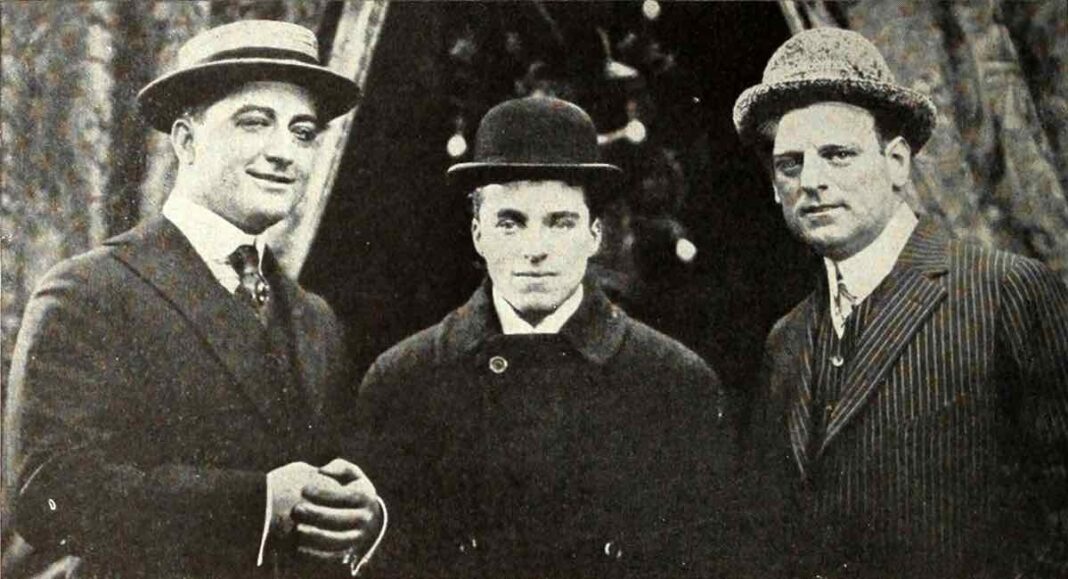In 1869 Niles was a sleepy agricultural town situated some 20 miles south of Oakland and 20 miles north of San Jose, almost in the shadow of Mission Peak. Then the train arrived, and Niles became one of the last links in the transcontinental railroad connecting the East and the West coasts. Surveyors had concluded that picturesque Niles Canyon offered the best route through the East Bay Hills and into the San Francisco Bay Area, so it was through there that the first Central Pacific railroad rolled into the Bay Area on Sept. 6, 1869.
Some 43 years later, in 1912, Gilbert “Bronco Billy” Anderson, cowboy star and director, decamped the train into Niles, the junction point linking Oakland, Stockton and Sacramento. Anderson liked what he saw—the rushing stream and steep ravines of Niles Canyon nestled among the wooded hills of the Diablo Range—and decided Niles would be home to the western division of the Essanay Film Manufacturing Company of Chicago (yes, the filmmakers didn’t direct films, they manufactured them).
Earlier, Anderson had worked with Thomas Edison at his movie studio in New York, including on the early Western, The Great Train Robbery, shot in New Jersey, in which he played a small role. But Anderson thought if he was going to make Westerns, they ought to be made in the West. Plus, he thought the scenery in Niles was superior to that of Los Angeles, where many smaller film companies were also setting up shop. So it was in Niles in 1913 that Essanay built 10 modest cottages for their actors on 2nd Street, between F and G streets, and constructed an unassuming studio nearby. And it was here that Anderson would set the pace and define the Western genre for years to come. He made some 375 Bronco Billy Westerns—serial Westerns shot on location, for the most part in Niles, and usually 12 to 14 minutes long—and they made him one of the earliest movie millionaires, “the millionaire cowboy,” as well as America’s first true movie star.
But he did something else, something prescient that put Niles and Essanay on the map. In 1914, for a lot of money, he lured young comic actor Charlie Chaplin away from Mack Sennett and Keystone Studios in Los Angeles.
So it was that almost overnight sleepy Niles found itself on the cutting edge of 20th century popular culture, with money pouring into the local businesses. Not just Bronco Billy and Chaplin, but Ben Turpin, Marie Dressler, Wallace Beery, Zasu Pitts and Ethel Clayton all passed through Niles in those heady early years.
By then Chaplin had made about 35 films for Keystone, including an early feature. He was already immensely popular and earning $100 a week plus bonuses. Anderson had been bowled over by Chaplin’s balletic grace and precise timing, even when he appeared to be stumbling about drunk. He offered Chaplin a then-astonishing $1,250 a week, with a $10,000 signing bonus. Plus, Chaplin would get to write and direct his own films. Not only was Sennett unhappy with this; Anderson’s partner in Chicago, the studio’s chief financier George K. Spoor who hadn’t even heard of Chaplin, fled the Windy City before Chaplin arrived to collect his bonus. Which left Chaplin wondering if he’d ever see the money.
In his autobiography, Chaplin describes cutting his last Keystone film in Los Angeles, then traveling north with Anderson, who he liked, to San Francisco. From there they drove to Niles where he said, when he saw the small studio, “my heart sank, for nothing could have been less inspiring.” Anderson told him he might like the Chicago studios better for making comedies, and soon after they left by train for Chicago. It was in December 1914, during the train ride, that they met two Midwestern sheriffs who were returning a convict wanted for murder to St. Louis. Immediately the excited convict recognized Bronco Billy but not Chaplin—something that would never happen again. During the next four months Chaplin’s star rose ever higher.
Chaplin didn’t like Chicago, he didn’t like Anderson’s cheapskate partner Spoor and he didn’t like being handed a script when he had every intention of writing his own. Moreover, the studio was partitioned more like a bank, and at six on the dot every evening, even if they were still shooting a scene, the place shut down like any factory or office. So after making one film, aptly titled His New Job, he fled with Anderson back to Niles.
Though he liked Anderson, he didn’t much like his working methods, later writing, “He had seven plots which he repeated over and over again…Sometimes he would turn out seven one-reel westerns in a week, then go on holiday for six weeks.”
His second Essanay two-reeler—and his first in Niles—was A Night Out, where he and the crossed-eyed Ben Turpin stagger around artfully drunk, negotiating a restaurant and then a hotel, and fighting against the world and then each other. Chaplin is, at this point, recognizably Chaplin; he has the bowler hat, the cane and the sloppy, outsized jacket and pants. The film also starred a college student, Edna Purviance, who’d been found working as a waitress in San Francisco but had no acting experience. As it turned out, her poise and delicacy proved a perfect balance and foil to Chaplin’s antics, and she appeared in his movies over the next eight years, as well as lived with him in one of the small Essanay cottages in Niles while they worked there. To this day, many critics think Chaplin never found a better female screen partner.
A Night Out was followed by the boxing comedy The Champion, which featured athletic antics, both in and out of the ring, as Chaplin proceeded to knock out his fellow boxers, one after another, as well as the referee. He also had a pet dog, a boxer of course, who occasionally came to his rescue. Anderson, incidentally, played an extra in an effort to make Chaplin feel more at home in Niles (which he never did).
After that came In the Park, shot either in Niles or Golden Gate Park (though the flowing river in one sequence suggests Niles). Chaplin again plays a tramp, still a pretty rough fellow, working the park as a pickpocket and at one point using an unconscious enemy’s open mouth as an ashtray. Still, it was in Niles where he began smoothing out the character of the tramp, who had first appeared in the madcap Keystone comedies; and perhaps not surprisingly, many felt his growing involvement with Purviance contributed to this addition of emotional depth to the tramp character. Charlie was in love, and it affected his art for the better.
Come March, Chaplin directed his fifth and final film for the Niles studio, The Tramp, a film considered his first classic. Shot in Niles Canyon, it’s the first film in which he introduced notes of melancholy and pathos to his comedy. The tramp ambles along a path and then, starving, he starts eating grass. A short time later he rescues a farmer’s daughter, played by Purviance, who’s getting mugged by a trio of robbers. Her father rewards him with a farm job, but the character is so clumsy he can’t even carry a candle without accidentally setting someone on fire. However, the gang returns and he chases them off again, though this time gets shot in the leg. Nursed back to health by the farmer’s daughter, he mistakes her kindness for love. But then her handsome boyfriend returns and the tramp, sadly realizing his love was one-sided, leaves.
That bittersweet departure remains, more than a century later, not only the most memorable departure in cinema, but one of cinema’s great endings. The Tramp leaves, shuffling sadly down the same long and dusty road he arrived in town on, alone once more, his hunched back to the camera, his hobo’s sack in one hand, his cane in the other, a tiny, ragged figure isolated in the countryside. Then, a shrug, a snap of his heels, a swing of his cane and he continues on a bit more jauntily, a touch more hopefully. The iris shrinks to encircle his receding figure and fades out.
Chaplin would use this wistful ending, this most lyrical of images, several more times with variations over the years, including with a woman, a fellow tramp. It became, in effect, his signature, and it sealed his fame. The most famous comedian of the cinema, the man whose face would soon become recognizable the world over, would nonetheless be most enduringly identified with this single melancholy image of the Tramp, his back to the camera, trudging off into the horizon. A century later the ending still holds its own alongside classic endings in movies as varied as Casablanca, Shadow of a Doubt, Some Like It Hot, The Four Hundred Blows and The Godfather Part II.
Chaplin became wealthy, Essanay was able to demand and get huge advances from exhibitors and an unauthorized Chaplin industry bloomed—Charlie squirt rings, Charlie statuettes, etc. Ziegfeld Follies girls, decked out in Tramp costumes, danced the night away. But Chaplin, for the most part isolated in Niles, was barely aware of his exploding popularity. Brother Sydney, still at Keystone, tried to track all the unlicensed merchandise, but it was an impossible task.
Soon after completing The Tramp, Chaplin, who still thought Niles too isolated, too rural and too poorly equipped for his tastes, left for Los Angeles, where he made eight more films for Essanay, thus completing his contract. His Niles residency had lasted only three months, but during that time his magic touched the place.
The Essanay studio in Niles continued to churn out films for almost another year. Then on Feb. 16, 1916, in the midst of a shoot, a telegram arrived from Spoor in Chicago, and the shoot ended then and there. Spoor had pulled the plug. The studio that had produced some 700 films was left deserted on Main Street, boarded up and padlocked. And the citizens of Niles were stunned. Their town was no longer in the running with L.A. to become the movie capital of America. Local kids played in the abandoned studio. Reels of film left in a cellar vanished or suffered nitrate decomposition and vandalism. The studio property changed hands, unused, until 1933, when it was leveled and many Bronco Billy negatives destroyed. Then, in 1956, Niles itself was incorporated into the city of Fremont.
Still, to this day Niles remains geographically separate, bounded by the Alameda Creek Flood Control Channel and by Route 238, and backed up against East Bay hills that are, for the most part, regional parks. Even today, if the Tramp were to suddenly materialize, he could probably just as magically once more disappear up the ruggedly beautiful Niles Canyon.
Chaplin’s Essanay Comedies 1915 is available in a Blu-Ray/DVD Collection of 15 painstakingly restored films from the Blackhawk Films Collection presented by Flicker Alley.












Excellent ..
i remember
the original
full length cover story
the East Bay Express ran
in the 1980s ..
It’s nice to see
this shorter one
as well ..